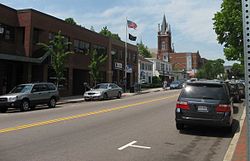Watertown (MA)
| Watertown, Massachusetts | ||
|---|---|---|
| City | ||

Watertown's Main Street
|
||
|
||
| Motto(s): In pace condita (Latin) "Founded in peace" |
||
 Location in Middlesex County in Massachusetts |
||
| Location in the United States | ||
| Coordinates: 42°22′15″N 71°11′00″W / 42.37083°N 71.18333°WCoordinates: 42°22′15″N 71°11′00″W / 42.37083°N 71.18333°W | ||
| Country | United States | |
| State | Massachusetts | |
| County | Middlesex | |
| Settled | 1630 | |
| Incorporated | 1630 | |
| Government | ||
| • Type | Council-manager | |
| • City Manager | Michael J. Driscoll | |
| Area | ||
| • Total | 4.2 sq mi (10.8 km2) | |
| • Land | 4.1 sq mi (10.6 km2) | |
| • Water | 0.1 sq mi (0.1 km2) | |
| Elevation | 36 ft (11 m) | |
| Population (2010) | ||
| • Total | 31,915 | |
| • Estimate (2016) | 35,025 | |
| • Density | 7,600/sq mi (3,000/km2) | |
| Time zone | Eastern (UTC-5) | |
| • Summer (DST) | Eastern (UTC-4) | |
| ZIP code | 02472 | |
| Area code(s) | 617 / 857 | |
| FIPS code | 25-73440 | |
| GNIS feature ID | 0612401 | |
| Website | http://www.ci.watertown.ma.us/ | |
The Town of Watertown is a city in Middlesex County, Massachusetts, United States. It is part of the Greater Boston area. The population was 31,915 at the 2010 census. Watertown is one of fourteen Massachusetts municipalities that have applied for, and been granted, city forms of government but wish to retain "The town of" in their official names.
Watertown is made up of six neighborhoods: Bemis, Brigham (Brigham Historic District), Coolidge Square, East Watertown, Watertown Square and the West End.
Archeological evidence suggests that Watertown was inhabited for thousands of years before the arrival of settlers from England. Two tribes of Massachusett, the Pequossette and the Nonantum, had settlements on the banks of the river later called the Charles. The Pequossette built a fishing weir to trap herring at the site of the current Watertown Dam. The annual fish migration, as both alewife and blueback herring swim upstream from their adult home in the sea to spawn in the fresh water where they were hatched, still occurs every spring.
Watertown, first known as Saltonstall Plantation, was one of the earliest of the Massachusetts Bay Colony settlements. Founded in early 1630 by a group of settlers led by Richard Saltonstall and George Phillips, it was officially incorporated that same year. The alternate spelling "Waterton" is seen in some early documents.
The first buildings were upon land now included within the limits of Cambridge known as Gerry's Landing. For its first quarter century Watertown ranked next to Boston in population and area. Since then its limits have been greatly reduced. Thrice portions have been added to Cambridge, and it has contributed territory to form the new towns of Weston (1712), Waltham (1738), Lincoln (1754) and Belmont (1859). In 1632 the residents of Watertown protested against being compelled to pay a tax for the erection of a fort at Cambridge; this was the first protest in America against taxation without representation and led to the establishment of representative democracy in the colony. As early as the close of the 17th century, Watertown was the chief horse and cattle market in New England and was known for its fertile gardens and fine estates. Here about 1632 was erected the first gristmill in the colony, and in 1662 one of the first woolen mills in America was built here.
...
Wikipedia


